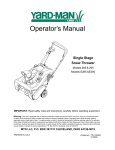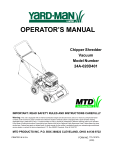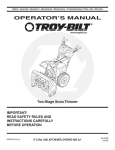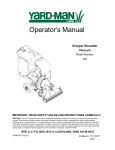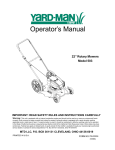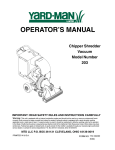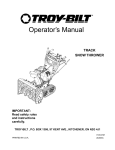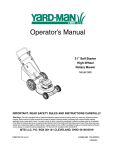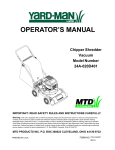Download Yard-Man 7L3 Operator`s manual
Transcript
Operator’s Manual SNOW THROWER MODEL 31AH7S3G701 IMPORTANT: READ SAFETY RULES AND INSTRUCTIONS CAREFULLY Warning: This unit is equipped with an internal combustion engine and should not be used on or near any unimproved forestcovered, brush-covered or grass-covered land unless the engine’s exhaust system is equipped with a spark arrester meeting applicable local or state laws (if any). If a spark arrester is used, it should be maintained in effective working order by the operator. In the State of California the above is required by law (Section 4442 of the California Public Resources Code). Other states may have similar laws. Federal laws apply on federal lands. A spark arrester for the muffler is available through your nearest engine authorized service dealer or contact the service department, P.O. Box 361131 Cleveland, Ohio 44136-0019. MTD LLC P.O. BOX 361131 CLEVELAND, OHIO 44136-0019 PRINTED IN U.S.A. FORM NO. 770-10021G.fm (5/05) TABLE OF CONTENTS Content Important Safe Operation Practices Assembling Your Snow Thrower Know Your Snow Thrower Operating Your Snow Thrower Adjusting Your Snow Thrower Page 3 5 6 8 10 Content Maintaining Your Snow Thrower Servicing Your Snow Thrower Trouble Shooting Illustrated Parts List Warranty Page 12 13 16 18 28 FINDING MODEL NUMBER This Operator’s Manual is an important part of your new snow thrower. It will help you assemble, prepare and maintain the unit for best performance. Please read and understand what it says. Before you start assembling your new equipment, please locate the model plate on the equipment and copy the information from it in the space provided below. A sample model plate is also given below. You can locate the model plate by looking at the lower frame cover on the rear of your snow thrower. This information will be necessary to use the manufacturer’s web site and/or help from the Customer Support Department or an authorized service dealer. Copy the model number here: www.yardman.com MTD LLC P. O. BOX 361131 CLEVELAND,OH 44136 330-220-4683 800-800-7310 Copy the serial number here: CUSTOMER SUPPORT Please do NOT return the unit to the retailer from where it was purchased, without first contacting Customer Support. If you have difficulty assembling this product or have any questions regarding the controls, operation or maintenance of this unit, you can seek help from the experts. Choose from the options below: Visit yardman.com for many useful suggestions. Click on the Customer Support menu option. If you prefer to reach a Customer Support Representative, please call 1-800-800-7310. Engine Manual The engine manufacturer is responsible for all engine-related issues with regards to performance, power-rating, specifications, warranty and service. Please refer to the engine manufacturer’s Owner’s/Operator’s Manual, packed separately with your unit, for more information. 2 SECTION 1: IMPORTANT SAFE OPERATION PRACTICES WARNING: This symbol points out important safety instructions which, if not followed, could endanger the personal safety and/or property of yourself and others. Read and follow all instructions in this manual before attempting to operate this machine. Failure to comply with these instructions may result in personal injury. When you see this symbol—heed its warning. WARNING: Engine Exhaust, some of its constituents, and certain vehicle components contain or emit chemicals known to the State of California to cause cancer, birth defects or other reproductive harm. DANGER: This machine was built to be operated according to the rules for safe operation in this manual. As with any type of power equipment, carelessness or error on the part of the operator can result in serious injury. This machine is capable of amputating hands and feet and throwing objects. Failure to observe the following safety instructions could result in serious injury or death. TRAINING 1. 2. 3. 4. 5. 6. 7. 7. Read, understand, and follow all instructions on the machine and in the manual(s) before attempting to assemble and operate. Keep this manual in a safe place for future and regular reference and for ordering replacement parts. Be familiar with all controls and their proper operation. Know how to stop the machine and disengage them quickly. Never allow children under 14 years old to operate this machine. Children 14 years old and over should read and understand the operation instructions and safety rules in this manual and should be trained and supervised by a parent. Never allow adults to operate this machine without proper instruction. Thrown objects can cause serious personal injury. Plan your snow-throwing pattern to avoid discharge of material toward roads, bystanders and the like. Keep bystanders, helpers, pets and children at least 75 feet from the machine while it is in operation. Stop machine if anyone enters the area. Exercise caution to avoid slipping or falling, especially when operating in reverse. 8. 9. PREPARATION 1. 2. 3. 4. 5. 6. Thoroughly inspect the area where the equipment is to be used. Remove all doormats, newspapers, sleds, boards, wires and other foreign objects, which could be tripped over or thrown by the auger/impeller. Always wear safety glasses or eye shields during operation and while performing an adjustment or repair to protect your eyes. Thrown objects which ricochet can cause serious injury to the eyes. Do not operate without wearing adequate winter outer garments. Do not wear jewelry, long scarves or other loose clothing, which could become entangled in moving parts. Wear footwear which will improve footing on slippery surfaces. Use a grounded three-wire extension cord and receptacle for all units with electric start engines. Adjust collector housing height to clear gravel or crushed rock surfaces. Disengage all clutch levers before starting the engine. Never attempt to make any adjustments while engine is running, except where specifically recommended in the operator’s manual. Let engine and machine adjust to outdoor temperature before starting to clear snow. To avoid personal injury or property damage use extreme care in handling gasoline. Gasoline is extremely flammable and the vapors are explosive. Serious personal injury can occur when gasoline is spilled on yourself or your clothes, which can ignite. Wash your skin and change clothes immediately. a. Use only an approved gasoline container. b. Extinguish all cigarettes, cigars, pipes and other sources of ignition. c. Never fuel machine indoors. d. Never remove gas cap or add fuel while the engine is hot or running. e. Allow engine to cool at least two minutes before refueling. f. Never over fill fuel tank. Fill tank to no more than ½ inch below bottom of filler neck to provide space for fuel expansion. g. Replace gasoline cap and tighten securely. h. If gasoline is spilled, wipe it off the engine and equipment. Move machine to another area. Wait 5 minutes before starting the engine. i. Never store the machine or fuel container inside where there is an open flame, spark or pilot light (e.g. furnace, water heater, space heater, clothes dryer etc.). j. Allow machine to cool at least 5 minutes before storing. OPERATION 1. 2. 3. 4. 3 Do not put hands or feet near rotating parts, in the auger/ impeller housing or chute assembly. Contact with the rotating parts can amputate hands and feet. The auger/impeller control is a safety device. Never bypass its operation. Doing so makes the machine unsafe and may cause personal injury. The controls must operate easily in both directions and automatically return to the disengaged position when released. Never operate with a missing or damaged chute assembly. Keep all safety devices in place and working. 5. 6. 7. 8. 9. 10. 11. 12. 13. 14. 15. 16. 17. 18. 19. 20. MAINTENANCE AND STORAGE Never run an engine indoors or in a poorly ventilated area. Engine exhaust contains carbon monoxide, an odorless and deadly gas. Do not operate machine while under the influence of alcohol or drugs. Muffler and engine become hot and can cause a burn. Do not touch. Exercise extreme caution when operating on or crossing gravel surfaces. Stay alert for hidden hazards or traffic. Exercise caution when changing direction and while operating on slopes. Plan your snow-throwing pattern to avoid discharge towards windows, walls, cars etc. Thus, avoiding possible property damage or personal injury caused by a ricochet. Never direct discharge at children, bystanders and pets or allow anyone in front of the machine. Do not overload machine capacity by attempting to clear snow at too fast of a rate. Never operate this machine without good visibility or light. Always be sure of your footing and keep a firm hold on the handles. Walk, never run. Disengage power to the auger/impeller when transporting or not in use. Never operate machine at high transport speeds on slippery surfaces. Look down and behind and use care when in reverse. If the machine should start to vibrate abnormally, stop the engine, disconnect the spark plug wire and ground it against the engine. Inspect thoroughly for damage. Repair any damage before starting and operating. Disengage all controls and stop engine before you leave the operating position (behind the handles). Wait until the auger/impeller comes to a complete stop before unclogging the chute assembly, making any adjustments, or inspections. Never put your hand in the discharge or collector openings. Always use the clean-out tool provided to unclog the discharge opening. Do not unclog chute assembly while engine is running.Shut off engine and remain behind handles until all moving parts have stopped before unclogging. Use only attachments and accessories approved by the manufacturer (e.g. wheel weights, tire chains, cabs etc.). If situations occur which are not covered in this manual, use care and good judgment. Contact your dealer or telephone 1-800-800-7310 for assistance and the name of your nearest servicing dealer. 1. Never tamper with safety devices. Check their proper operation regularly. Refer to the maintenance and adjustment sections of this manual. 2. Before cleaning, repairing, or inspecting machine disengage all controls and stop engine. Wait until the auger/impeller come to a complete stop. Disconnect the spark plug wire and ground against the engine to prevent unintended starting. 3. Check bolts and screws for proper tightness at frequent intervals to keep the machine in safe working condition. Also, visually inspect machine for any damage. 4. Do not change the engine governor setting or over-speed the engine. The governor controls the maximum safe operating speed of the engine. 5. Snow thrower shave plates and skid shoes are subject to wear and damage. For your safety protection, frequently check all components and replace with original equipment manufacturer’s (OEM) parts only. “Use of parts which do not meet the original equipment specifications may lead to improper performance and compromise safety!” 6. Check clutch controls periodically to verify they engage and disengage properly and adjust, if necessary. Refer to the adjustment section in this operator’s manual for instructions. 7. Maintain or replace safety and instruction labels, as necessary. 8. Observe proper disposal laws and regulations for gas, oil, etc. to protect the environment. 9. Prior to storing, run machine a few minutes to clear snow from machine and prevent freeze up of auger/impeller. 10. Never store the machine or fuel container inside where there is an open flame, spark or pilot light such as a water heater, furnace, clothes dryer etc. 11. Always refer to the operator’s manual for proper instructions on off-season storage. WARNING: Restrict the use of this power machine to persons who read, understand and follow the warnings and instructions in this manual and on the machine. 4 SECTION 2: ASSEMBLING YOUR SNOW THROWER • NOTE: References to right or left side of the snow thrower are determined from behind the unit in the operating position. The “operator’s position” is defined as standing directly behind the snow thrower, facing the handle panel. • • Unpacking • • • • • Remove screws from the top sides and ends of the shipping crate. Set panel aside to avoid tire punctures or personal injury. Remove and discard plastic bag that covers unit. Remove any loose parts included with unit (i.e., Operator’s Manual, etc.). Roll unit out of crate. Raise the upper handle assembly until it locks over the lower handle. Look at the lower rear of snow thrower frame to be sure both cables are aligned with cable roller guides. Secure the upper handle and lower handle with the two plastic wing knobs, cupped washers and carriage bolts previously removed and tighten the upper two plastic wing knobs. See Figure 3. Upper Chute Rod Bracket Carriage Bolt Cupped Washer Loose Parts The augers are secured to the auger shaft with two shear pins and cotter pins. If you hit a foreign object or ice jam, the snow thrower is designed so that the pins may shear. Two replacement shear pins and cotter pins are provided for your convenience. Store in a safe place until needed. See Figure 1. Upper Chute Rod Wing Nut Shear Pins Shift Rod Connector Hairpin Clip Cotter Pins Carriage Bolt Figure 1 Lower Chute Rod Assembly Figure 3 WARNING: Disconnect the spark plug wire and ground it against the engine to prevent unintended starting. • • Remove the lower two plastic wing knobs, cupped washers and carriage bolts from each side of the lower handle. See Figure 2. Lower Handle Slide the shift rod connector down over the end of the lower shift rod. Tap the connector until it locks on the lower shift rod. See Figure 3. NOTE: If the connector is not properly assembled, the shift rod will pivot and you will not be able to change speeds or change directions. Handle Panel Attaching Chute Directional Control • • Upper Handle Wing Knobs, Washers, & Bolts Figure 2 5 Remove the hairpin clip from the upper chute rod and slide the upper chute rod through the upper chute rod bracket and into the lower chute rod. A pair of pliers may help in this job. Align the two holes on both chute rods and insert the hairpin clip removed earlier, through these holes. See Figure 3. • • If not already attached, slip the cables that run from the handle panel to the chute into the cable guide located on top of the engine. See Figure 4. Unwrap the headlight wire, which is attached to the headlight beneath the handle panel. Wind the headlight wire around the right handle until excess slack is removed. Plug the wire from the headlight into the wire lead coming from the right side of the engine, beneath the fuel tank. • Cable Guide • Figure 4 SECTION 3: KNOW YOUR SNOW THROWER Drive Control / Auger Control Lock Shift Lever Chute Tilt Control Heated Handles Switch Clean-out Tool Auger Control Headlight Chute Assembly Track Steering Control Electric Starter Button Primer Chute Directional Control Auger Switch Box Choke Safety Ignition Key Skid Shoe Throttle Control Recoil Starter Handle Figure 5 WARNING: Read, understand, and follow all instructions and warnings on the machine and in this manual before operating. IMPORTANT: Always release drive control before changing speeds. Auger Control The auger control is located on the left handle. Squeeze the auger control to engage the augers. Release to stop the snow throwing action. (Drive control must also be released.) See Figure 5. Drive Control / Auger Control Lock The drive control is located on the right handle. Squeeze the drive control to engage the wheel drive. Release to stop. See Figure 5. IMPORTANT: Refer to Auger Control Test on page 9 prior to The drive control also locks the auger control so you can turn the chute directional control without interrupting the snow throwing process. If the auger control is engaged along with the drive control, the operator can release the auger control (on the left handle) and the augers will remain engaged. Release both controls to stop the augers and track drive. operating your snow thrower. Read and follow all instructions carefully and perform all adjustments to verify your snow thrower is operating safely and properly. 6 Chute Tilt Control NOTE: It is easier to maneuver a non-running snow thrower with both track steering controls held in simultaneously. The distance snow is thrown can be changed by adjusting the angle of the upper chute. Move the chute tilt control forward to decrease the distance, and backwards to increase distance. See Figure 5. Throttle Control The throttle control is located on the engine. It regulates the speed of the engine and will shut off the engine when pushed down completely. See Figure 5. Skid Shoe The space between the shave plate and the ground can be adjusted by positioning the skid shoes. Refer to Skid Shoe Adjustment on page 11. Safety Ignition Key The safety ignition key must be fully inserted and snapped in place before the unit will start. Remove the ignition key to prevent unauthorized use of equipment. See Figure 5. Shift Lever The shift lever is located in the center of the handle panel and is used to determine both ground speed and direction of travel. It can be moved into any of eight positions. See Figure 5. IMPORTANT: Do NOT attempt to turn the key. Headlight Forward The headlight is on whenever the engine is running. Your snow thrower has six forward (F) speeds, with position number one (1) being the slowest speed. Track Lock Lever Reverse Your snow thrower has two reverse (R) speeds, with position number one (1) being the slowest speed. The track lock lever is located on the right side of the snow thrower and is used to select the position of the auger housing and the method of track operation. Move the lever to the right, then forward or backward to one of the three positions. See Figure 6. IMPORTANT: Always release drive control before changing speeds. Transport: Raises the front end of the snow thrower for Chute Directional Control The chute directional control is located on left side of the snow thrower. See Figure 5. easy transport. Using proper caution, this position may also be used on many gravel driveways to clear snow while leaving gravel undisturbed. To change the direction in which snow is thrown, turn chute directional control as follows: Normal Snow: Allows the tracks to be suspended • • independently for continuous ground contact. Crank clockwise to discharge to the left. Crank counterclockwise to discharge to the right. Packed Snow: Locks the front end of the snow thrower down to the ground for hard-packed or icy snow conditions. Heated Handles Switch Track Lock Lever This switch is located on the right side of the snow thrower dash panel. To activate the heated handles, toggle the switch to the right to generate heat within the handle grips. Toggle the switch to the left to the OFF position after using the snow thrower. See Figure 5. Packed Snow NOTE: The heated handles grips are a compliment to, not a substitute for, proper cold weather outerwear for the operator’s hands. It is recommended that the snow thrower operator wear gloves/mittens to avoid extremities of winter while operating this equipment. Track Steering Controls Normal Snow The left and right track steering controls are located on the underside of the handles and they are used to assist in steering the snow thrower. Squeeze the right track control when turning right, squeeze the left control when turning left. Operate your snow thrower in open areas until you become familiar with these controls. See Figure 5. Transport Figure 6 7 SECTION 4: OPERATING YOUR SNOW THROWER Before Starting • WARNING: Read, understand, and follow all instructions and warnings on the machine and in this manual before operating. • • Gas And Oil Fill-up • Service the engine with gasoline and oil as instructed in the separate engine manual packed with your snow thrower. Read instructions carefully. • WARNING: Use extreme care when handling gasoline. Gasoline is extremely flammable and the vapors are explosive. Never fuel machine indoors or while the engine is hot or running. Extinguish cigarettes, cigars, pipes an other sources of ignition. • • • A plastic cup may be provided inside the fuel fill opening to protect the tank during manufacturing. Remove and discard. Use the threaded fuel tank cap to close after fill-up. • Recoil Starter • To Start Engine • • • Attach spark plug wire to spark plug. Make certain the metal loop on end of the spark plug wire (inside the boot) is fastened securely over the metal tip on the spark plug. Make certain the auger and drive controls are in the disengaged (up) position. Move throttle control up to FAST position. Insert ignition key into slot and snap in place. See Figure 5. Do not turn key. • • • Electric Starter • • Rotate choke knob to FULL choke position (cold engine start). If engine is warm, place choke in OFF position instead of FULL. Push primer button two or three times. If engine is warm, push primer button once only. NOTE: Always cover vent hole in primer button when pushing. Additional priming may be necessary for first start if temperature is below 15°F. NOTE: Engine will not start unless ignition key is inserted into ignition slot in carburetor cover. • If your home electrical system is grounded, but a three-hole receptacle is not available, one should be installed by a licensed electrician before using the electric starter. If you have a grounded three-prong receptacle, proceed as follows: Move engine speed control to “Fast” position and set Choke Control to “Full” position. Push Primer three (3) times, making sure to cover vent hole when pushing. Connect power cord to switch box on engine. Plug the other end of power cord into a three-hole, grounded 120 volt AC receptacle. Push starter button on top of the engine to crank engine. As you crank the engine, move choke knob to FULL choke position. When engine starts, release starter button, and move choke gradually to OFF. If engine falters, move choke immediately to FULL and then gradually to OFF. When disconnecting the power cord, always unplug from the three-prong receptacle first and then from the snow thrower. Determine that your house wiring is a three-wire grounded system. Ask a licensed electrician if you are not certain. If your house wiring system is not a three-wire grounded system, do not use this electric starter under any conditions. Grasp starter handle and pull rope out slowly, until it pulls slightly harder. Let rope rewind slowly. Pull starter handle rapidly. Do not allow handle to snap back. Allow it to rewind slowly while keeping a firm hold on the starter handle. Repeat the previous steps until engine starts. To Stop Engine • • WARNING: The electric starter is equipped with a grounded three-wire power cord and plug and is designed to operate on 120 volt AC household current. It must be used with a properly grounded three-prong receptacle at all times to avoid the possibility of electric shock. Follow all instructions carefully prior to operating the electric starter. Run engine for a few minutes before stopping to help dry off any moisture on the engine. To help prevent possible freeze-up of starter, proceed as follows: Electric Starter: • 8 Connect power cord to switch box on engine, then to 120 volt AC receptacle. With the engine running, push starter button and spin the starter for several seconds. The unusual sound made by spinning the starter will not harm engine or starter. Disconnect the power cord from receptacle first, and then from switch box. Recoil Starter IMPORTANT: If the auger shows ANY signs of rotating, • immediately return to the operator’s position and shut off the engine. Wait for ALL moving parts to stop before re-adjusting the auger control. • • With engine running, pull starter rope with a rapid, continuous full arm stroke three or four times. Pulling the starter rope will produce a loud clattering sound, which is not harmful to the engine or starter. To stop engine, move throttle control to “stop” or “off” position. Remove ignition key (DO NOT turn key) to prevent unauthorized use of equipment. • • • • NOTE: Do not lose ignition key. Keep it in a safe place. Engine will not start without ignition key. • Wipe all snow and moisture from the carburetor cover in the area of the control levers. Also, move control levers back and forth several times. To readjust the control cable, loosen the hex jam nut on the auger control cable “Z” fitting. Rotate the coupling end of the cable counterclockwise to provide more slack. Retighten the hex jam nut. See Figure 7. Repeat Auger Control Test to verify proper adjustment has been achieved. Repeat the previous steps to provide more slack in cable, if necessary. Auger Control To Engage Track Drive • • • • With the engine running near top speed, move the shift lever into one of the six FORWARD positions or two REVERSE positions. Select a speed appropriate for the snow conditions that exist. Squeeze the auger control and the augers will turn. Release it and the augers will stop. Squeeze the drive control and the snow thrower will move. Release it and drive motion will stop. NEVER move shift lever without releasing drive control. Z-End Jam Nut Auger Control Cable Figure 7 To Engage Augers • Clean-Out Tool To engage the augers and start throwing snow, squeeze the auger control against the left handle. Release to stop the augers. The clean-out tool is conveniently fastened to the rear of the auger housing with a mounting clip. Should snow and ice lodge itself in the chute assembly during operation, proceed as follows to safely clean the chute and chute opening: Auger Control Test IMPORTANT: Perform the following test before operating your snow thrower for the first time and at the start of each winter season. • Check the adjustment of the auger control as follows: • • • • • • • When the auger control is released and in the disengaged “up” position, the cable should have very little slack. It should NOT be tight. In a well-ventilated area, start the snow thrower engine as instructed earlier in this section under the heading Starting Engine. Make sure the throttle is set in the FAST position. While standing in the operator’s position (behind the snow thrower), engage the auger. Allow the auger to remain engaged for approximately ten (10) seconds before releasing the auger control. Repeat this several times. With the engine running in the FAST position and the auger control in the disengaged “up” position, walk to the front of the machine. Confirm that the auger has completely stopped rotating and shows NO signs of motion. • • Release both the Auger Control and the Drive/ Auger Control Lock. Stop the engine by moving the throttle to the stop position. Remove the clean-out tool from the mounting clip. Use the shovel-shaped end of the clean-out tool to dislodge and scoop any snow and ice which has formed in and near the chute assembly. WARNING: Never use your hands to clean snow and ice from the chute or auger housing. Use the clean-out tool or a stick to unclog. • • 9 Refasten the clean-out tool to the mounting clip on the rear of the auger housing, and restart the engine. While standing in the operator’s position (behind the snow thrower), engage the auger control for a few seconds to clear any remaining snow and ice from the chute assembly. Drift Cutters (If Equipped) WARNING: The temperature of the muffler and the surrounding areas may exceed 150°F. Avoid these areas. Drift cutters should be used when operating the snow thrower in heavy drift conditions. • If your unit is not equipped with drift cutters, contact Customer Support as instructed on page 2 for information regarding price and availability. Snow Thrower Model Drift Cutter Kit All models OEM-390-679 • • • Operating Tips NOTE: Allow the engine to warm up for a few minutes. The engine will not develop full power until it reaches operating temperature. • • For the most efficient snow removal, remove snow immediately after it falls. Discharge the snow downwind whenever possible. Slightly overlap each previous path. Set the skid shoes 1/4" below the shave plate for normal usage. The skid shoes may be adjusted upward (to lower the shave plate) for hard-packed snow. Adjust downward (to raise the shave plate) when using on gravel or crushed rock. Be certain to follow the precautions found in the To Stop Engine section to prevent possible freeze-up. Clean the snow thrower thoroughly after each use. SECTION 5: ADJUSTING YOUR SNOW THROWER If you are uncertain that you have reached the correct adjustment, proceed as follows: WARNING: NEVER attempt to make any adjustments while the engine is running, except where specified in the operator’s manual. WARNING: Drain the gasoline out of the snow thrower’s tank, or place a piece of plastic film under the gas cap to avoid spillage BEFORE making the adjustment. Auger Control Refer to Auger Control Test in the Operating Section to adjust the auger control. • Tip the snow thrower forward, allowing it to rest on the auger housing. See Figure 8. Frame Cover Drive Control and Shift Lever To check the adjustment of the drive control and shift lever, proceed as follows: • • • • • • • To check the adjustment of the traction control clutch and shift lever, proceed as follows: With the engine off, move the shift lever all the way forward to the highest speed. With the drive control released, push the snow thrower forward. The unit should roll forward. Then engage the drive control. The wheels should stop turning. Now release the drive control and push the unit again. Move the shift lever back to the fast reverse position then all the way forward again. There should be no resistance in the shift lever, and the wheels should keep turning. If you have resistance when moving the shift lever or the wheels stop when they should not, loosen the jam nut on the drive control cable and unthread the cable one turn. If the wheels do not stop when you engage the drive control, loosen the jam nut on the drive control cable and thread the cable in one turn. Recheck the adjustment and repeat as necessary. Tighten the jam nut to secure the cable when correct adjustment is reached. Auger Housing Figure 8 • • 10 Remove the frame cover underneath the snow thrower by removing the six self-tapping screws. With the drive control released, there must be clearance between the friction wheel and the drive plate in all positions of the shift lever. With the drive control engaged, the friction wheel must contact the drive plate. See Figure 9. If adjustment is necessary: • • IMPORTANT: Make certain to check for correct • • • Loosen the jam nut on the drive cable. Adjust the cable as necessary. Refer to Figure 7. Retighten the jam nut to secure the cable when correct adjustment is reached. Reassemble the frame cover. Reconnect the upper shift rod to the lower shift rod by reinserting the hairpin clip removed earlier and sliding the shift rod connector back down into place. adjustment of the shift rod as instructed under Final Adjustments in the Assembly Section, before operating the snow thrower Skid Shoes Drive Cable Gear Shaft The space between the shave plate and the ground can be adjusted. See Figure 11. • • Pivot Rod Friction Wheel Rubber For close snow removal on a smooth surface, raise skid shoes higher on the auger housing. Use a middle or lower position when the area to be cleared is uneven. Drive Plate Figure 9 NOTE: If you placed plastic film under the gas cap, be certain to remove it before operating the snow thrower. Shift Rod Adjustment To adjust the shift rod, proceed as follows: • • • • Remove the hairpin clip and slide the shift rod connector up, to separate the upper shift rod from the lower shift rod. See Figure 10. Place the shift lever into the sixth (6) position. Rotate the shift arm clockwise (from the operator’s position) as far as it will go. Thread the upper shift rod downward until the elbow on its lower end aligns with the hole found in the lower shift rod. Figure 11 WARNING: Do not operate this snow thrower on gravel as loose gravel can be easily picked up and thrown by the auger causing injury to the




























